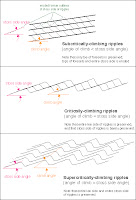Friday Field Foto #21: Climbing ripples
 Today we are gonna look at some ripple cross-laminated sandstone. More specifically these are called 'climbing ripples', or sometimes you may see this sedimentary structure referred to as 'ripple drift'. These show up particularly nice in this photo because of the light-dark contrast of the sandy vs. muddy laminae.
Today we are gonna look at some ripple cross-laminated sandstone. More specifically these are called 'climbing ripples', or sometimes you may see this sedimentary structure referred to as 'ripple drift'. These show up particularly nice in this photo because of the light-dark contrast of the sandy vs. muddy laminae.
Climbing ripples record both migration (lateral) and aggradation (vertical) of the bedform. In this example note the very prominent ripple set in the middle section of the photo nicely showing the 'climb' from left to right. Different angles of climb represent different ratios of migration and aggradation. Climbing ripples are commonly interbedded with or grade upwards into wavy laminae.
Climbing ripples are most commonly seen in river and turbidity current deposits, typically in sub-environments of high rates of deposition from decelerating flows.
On a side note, Dr. Lemming has pointed out a new geology-related blog out there. It's called All of My Faults Are Stress Related and looks to be a nice addition to the geoblogosphere. I have a few more new links over there on the sidebar that i'll post about soon.
I also have an updated album of Patagonia photos you can check out here. The above image is from that collection.

4 comments:
Do you know a good textbook or review paper for teaching one's self about cross-bedding interpretation and recognition?
Walker's textbook called "Facies Models" and Reading's text "Sedimentary Environments: Processes, Facies, and Stratigraphy" are great for depositional environment reconstruction.
If you want to get into the fluid mechanics of bedforms more then you need a textbook like Leeder's "Sedimentology and Sedimentary Basins: from turbulence to tectonics". The whole first half is pretty mathy.
There's a classic book by J.R.L. Allen in the late '70s but the name escapes me...I think it's called 'sedimentary structures' or something.
I'm trying to think of any shorter-than-textbook resources...but I can't. If you Google 'sedimentary structures' the first bunch are decent websites for some photos and such, but not much about their formation.
I will keep my eyes open for good resources.
ooops....i mis-typed up there...the 'climbing' of the ripple set in the photo is from right to left, not left to right
So how do we convey this (and related) information to non-geologists in such a way as to keep them coming back to read more?
Through a series of exposures in construction sites, ditches, and creeks, I have been informally tracing old river gravels and sands for close to 3/4 of a mile along a local highway, northeast of Atlanta, GA. In several places the underlying Piedmont saprolite is visible beneath the basal conglomerate.
The present-day course of the Chattahoochee River is about 1/2 mile west and about 30 - 40 feet lower than some of these gravels.
So how do we convey "why this stuff is neat" on a blog?
Post a Comment